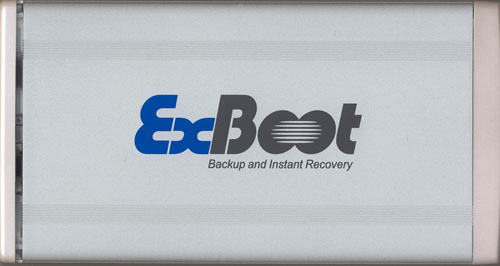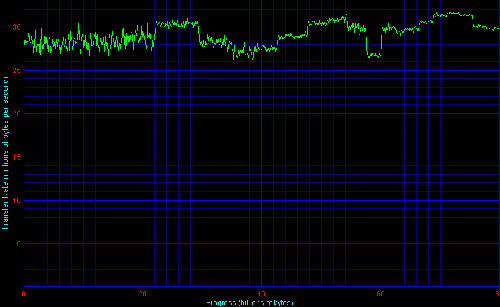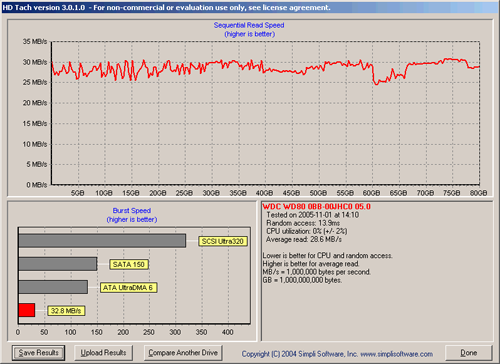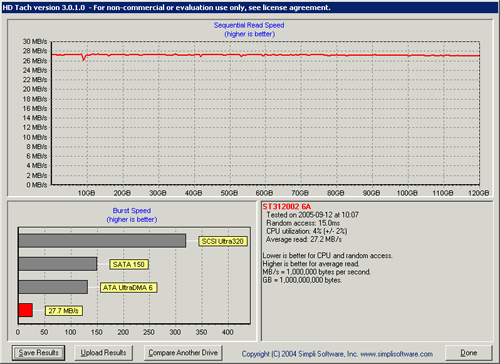
Original Link: https://www.anandtech.com/show/1856
AXIOMTEK ExBoot 80GB External Storage
by Purav Sanghani on November 10, 2005 12:05 AM EST- Posted in
- Storage
Introduction
AXIOMTEK is a manufacturer of storage solutions, including both SOHO and enterprise storage solutions as well as a few other products outside the storage realm. As we dig deeper in the area of external and networked storage, we are beginning to see that this area is not just limited to applications for the corporate world, which cost thousands of dollars, but it includes desktop and small office products as well. AXIOMTEK brings all of these solutions to consumers along with about 15 years of experience.
Recently, AXIOMTEK has brought to our attention their ExBoot line of 3.5” external desktop hard drives. We had a chance to look at their 80GB version of the ExBoot, which looks to be aimed at the typical home user due to its capacity and its single USB 2.0 interface.
Our look at both the AcomData E5 and Seagate’s 120GB brought us some results to which we can compare our future benchmark results and we will do just that. Take a look at how the ExBoot compares to these higher capacity drives.
The 80GB ExBoot External Drive
It would be a slight understatement if we said that the ExBoot was nothing special to look at. In its off-state, it looks like a normal 3.5” aluminum hard drive case with curves. However, when in the “on” state, the lights come up. Just behind the front plate of the enclosure, we see a transparent plastic that allows the multi-color, color-cycling LEDs to shine through. The button for the PushButton backup on the front bezel is also clear to allow this effect. The case features a large ExBoot logo on the right side in blue and gray.
Bezel of ExBoot
Click to enlarge.
Rear of ExBoot
Click to enlarge.
The inside of the ExBoot consists of a Western Digital WD800BB 80GB hard drive with a 7200RPM spindle speed and 2MB buffer.
The following 4 models are available from AXIOMTEK in the 3.5” size:
| Configurations for AXIOMTEK's External Drives | ||||
| Model No. | Capacity | Rotational Speed | Interface Transfer Rate | |
| EXB-0131/080 | 80 GB | 7200 RPM | USB 2.0: Up to 480 Mbps (60 Megabytes/s**). |
|
| EXB-0131/160 | 160 GB | 7200 RPM | ||
| EXB-0131/250 | 250 GB | 7200 RPM | ||
| EXB-0131/400 | 400 GB | 7200 RPM | ||
**Theoretical limit. Actual transfer rates may differ.
The Software
AXIOMTEK's backup software is somewhat trivial if you're looking for a full featured backup package. Seeing that this is the "Professional" version, it lacks the ability to configure the predefined backup that will be initiated by the PushButton backup feature. Scheduling backups are simple to do, but the only option available is a full drive backup. Finding that out, we better not have more than about 74GB of data on the drive that we are archiving.
What's included
Main ExBoot backup software screen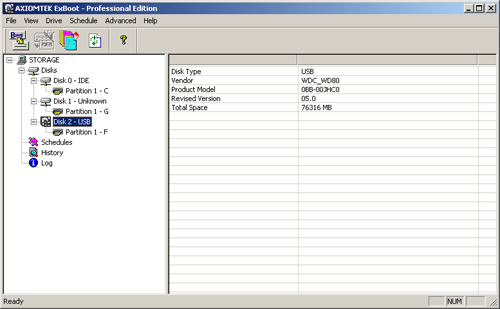
Click to enlarge.
Point-In-Time recovery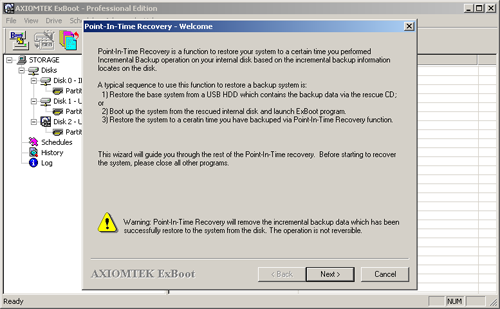
Click to enlarge.
System Tray Launcher 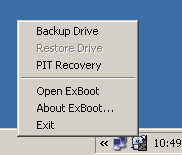
The Test
Our list of tests for external drives has many of the benchmarks as our internal hard disk drive, but we are focusing more on file system tasks, since external devices are mainly used for archival. We have not changed our test bed from our usual storage platform. Take a look at the details.
| AXIOMTEK ExBoot 80GB External Storage/Backup Test Bed | |
| Processor: | AMD Athlon 64 3500+ (2.2GHz, 512KB L2 Cache, Socket 939) |
| Motherboard/Chipset Drivers: | Giga-Byte GA-K8NXP-SLI nForce4 (v6.66) |
| Hard Disk Drive(s): | Seagate Barracuda 7200.8 400GB |
| RAM: | 1GB Corsair XMS4400 (2x512MB) |
| Video Card: | NVIDIA 6600GT 128MB SLI Edition (Single card) |
Our test methods are as follows:
WinBench 99 – transfer rates over the disk surface, disk access time, and CPU utilization
HDTach – Sequential read speeds and burst speeds
Real World File System Task Tests – timed tests of basic file system tasks including zipping/unzipping and copying files from a higher performance SATA drive to the external device, as well as within the external device
Real World Multitasking Test – timed tests of basic multitasking processes, timing a file zip operation while copying a larger 4.5GB file
WinBench 99
We have extended our WinBench 99 portion of our benchmarks to include not only the Disk Transfer Rate tests, but also a couple of other disk performance related tests including Disk Access Time and CPU Utilization. As we present our results, we will explain how each test is relevant in our methodology.
Disk Transfer Rate
In the past, we have just given the beginning and ending transfer rates, which doesn’t really show the performance of the entire disk because there is so much more in between that we are not reporting. Our new method includes a graph:
The WinBench 99 transfer rate test reports results that are extremely sporadic. Starting at a rate of 28.1 MB/sec, the ExBoot drive produces transfer rates anywhere between 26-31MB/sec. Later, we’ll see that HDTach produces similar results.
Disk Access Time
WinBench 99 also has a Disk Access Time test that gives us the summation of the latency, seek time, as well as any overhead involved in seeking data across the disk.
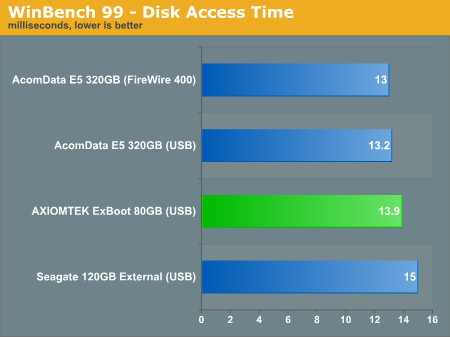
Disk CPU Utilization
The disk CPU utilization test measures the CPU usage while the hard drive transfers data at a rate of 4KB/sec. While transferring data, our test bed utilizes about 77% of the CPU time on average.
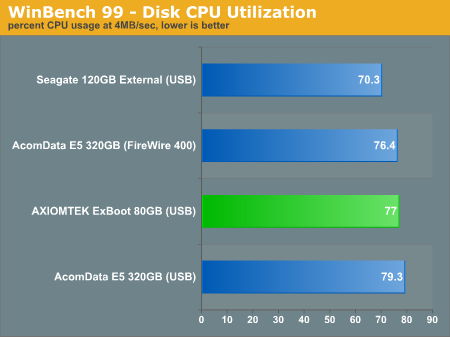
HDTach 3
HDTach provides another look into the transfer rates of a disk drive similar to WinBench 99’s transfer rate test. We perform three runs of HDTach to see if there is any variance in the results. For the 80GB ExBoot unit, we received the same results.
Compared to the Seagate 120GB external drive, the 80GB ExBoot is all over the place in HDTach’s sequential read speed test like WinBench 99’s transfer rate test. HDTach reports an average read speed of 28.6MB/sec as well as a 32.8MB/sec burst speed.
Real World Tests – File System Performance
For our Real World File System Performance tests, we have taken the original tests and tailored them for external drives. More specifically, instead of just measuring the time that it takes to copy, zip, and unzip within the same drive, we measure the time that it takes to perform these tasks from a SATA drive to the external device.
File Copy Operations
| File Copy – One 300MB File, seconds, lower is better | ||
| Within Drive | To Drive (From SATA) | |
| AcomData E5 320GB (USB) | 32.072 | 11.191 |
| AcomData E5 320GB (FireWire 400) | 20.573 | 11.334 |
| ExBoot 80GB USB | 30.495 | 9.828 |
| Seagate 120GB USB | 28.539 | 11.750 |
The E5 has no competition just yet with its FireWire interface when copying files within the drive. And though the ExBoot shows lower file copy times to the drive, the others are not far behind. Two seconds make very little difference here, but the advantage is still given to the ExBoot here.
| File Copy – Three Hundred 1MB Files, seconds, lower is better | ||
| Within Drive | To Drive (From SATA) | |
| AcomData E5 320GB (USB) | 13.298 | 13.219 |
| AcomData E5 320GB (FireWire 400) | 12.962 | 12.813 |
| ExBoot 80GB USB | 14.526 | 14.727 |
| Seagate 120GB USB | 13.516 | 13.711 |
The file copy time for three hundred 1MB files are extremely close, which tells us that the USB interface is the major bottleneck, as we would expect it to be.
File Zip Operations
| File Zip – One 300MB File, seconds, lower is better | ||
| Within Drive | To Drive (From SATA) | |
| AcomData E5 320GB (USB) | 69.195 | 70.734 |
| AcomData E5 320GB (FireWire 400) | 67.219 | 67.586 |
| ExBoot 80GB USB | 66.885 | 67.406 |
| Seagate 120GB USB | 67.688 | 67.443 |
| File Zip – Three Hundred 1MB Files, seconds, lower is better | ||
| Within Drive | To Drive (From SATA) | |
| AcomData E5 320GB (USB) | 71.775 | 71.621 |
| AcomData E5 320GB (FireWire 400) | 70.583 | 70.620 |
| ExBoot 80GB USB | 67.344 | 67.667 |
| Seagate 120GB USB | 68.906 | 70.805 |
File UnZip Operations
| File Unzip – One 300MB File, seconds, lower is better | ||
| Within Drive | To Drive (From SATA) | |
| AcomData E5 320GB (USB) | 15.761 | 15.699 |
| AcomData E5 320GB (FireWire 400) | 14.427 | 14.401 |
| ExBoot 80GB USB | 15.229 | 15.647 |
| Seagate 120GB USB | 15.476 | 15.485 |
| File Unzip – Three Hundred 1MB Files, seconds, lower is better | ||
| Within Drive | To Drive (From SATA) | |
| AcomData E5 320GB (USB) | 16.196 | 16.008 |
| AcomData E5 320GB (FireWire 400) | 14.901 | 14.995 |
| ExBoot 80GB USB | 16.021 | 16.679 |
| Seagate 120GB USB | 15.664 | 15.618 |
Real World Tests – Multitasking Performance
We apply the same changes to our Real World Multitasking Performance tests and have also modified the test to relate to typical external storage device uses. We now measure the time that it takes to zip a single 300MB file while copying a 4.5GB file to the external device from a SATA drive.
| Multitasking – 4GB File Copy + 300MB File Zip, seconds, lower is better | |||
| Within Drive | To Drive (From SATA) | Difference | |
| AcomData E5 320GB (USB) | 186.586 | 199.154 | 12.568 |
| AcomData E5 320GB (FireWire 400) | 173.453 | 187.438 | 13.985 |
| ExBoot 80GB USB | 102.296 | 107.594 | 5.298 |
| Seagate 120GB USB | 199.416 | 197.086 | 2.330 |
Surprisingly, the ExBoot takes the lead here, chopping off up to 90 seconds to zip a 300MB file to the drive while copying a 4GB file to the drive at the same time. We are surprised to see this with the ExBoot holding a drive that has lower density platters and a smaller buffer.
Final Thoughts
With a capacity of 80GB, the ExBoot is a good choice for those who are looking for a drive that will back up their smaller home PC drives. This drive, however, would not fit a small business, or even the average multimedia fanatic, as 80GB of hard disk space is becoming less common, even at home.
The performance of the drive surprised us, seeing that the WD800BB uses three 27GB platters, a much lower density than what the drives in the E5 and Seagate’s 120GB drive use. The single benchmark that gave us comfort was the last multitasking test where we zipped a 300MB file to the drive from our SATA test bed drive while copying a 4GB file to the drive as well. The time to zip the file to the drive took almost 90 seconds less compared to the Seagate 120GB and even shorter than 90 seconds compared to the E5’s USB interface.
The software is mediocre at best. It does its job in doing a full backup during its schedules, but it does not allows us to choose what files we want backed up, but rather a single option to backup/restore an entire volume. This is trouble if your source drive is larger than 74GB. The PushButton backup assignment is also frustrating, in that we cannot assign a predefined backup to the button. The E5’s bundled Retrospect Express and the Bounceback Express that came with the Seagate drive were fullly featured, even with their “Express” naming convention. We were able to choose what files we wanted to back up instead of having our options limited.
The ExBoot 80GB has a low capacity and software that just barely does its job. There are a handful of drives out there, if not more, that have full-featured software packages and larger capacities that can do their job much more efficiently, and for this reason, we cannot recommend this drive to even the average user.

